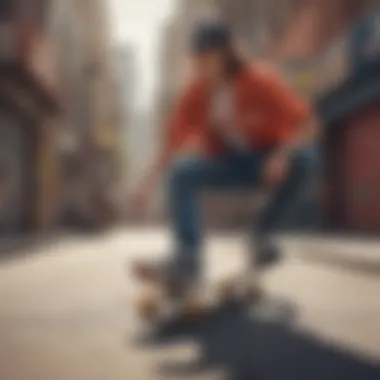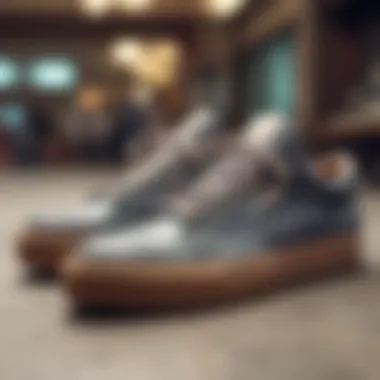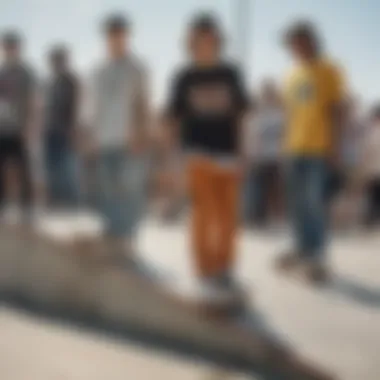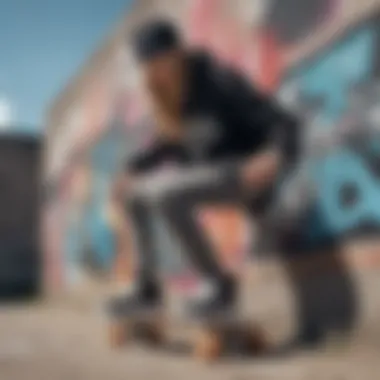Urban Fashion: Style and Identity in Skate Culture


Intro
Urban fashion in the context of skateboarding culture holds a mirror to society's shifting dynamics. Skaters are not just performers in a sport; they are a vibrant subculture, a tapestry woven with threads of creativity, rebellion, and individuality. As skateboarding has grown from an underground pastime to a global phenomenon, the influence of urban fashion has become undeniably prominent, reflecting social issues and providing a canvas for self-expression.
The clothes chosen by skaters are not merely functional; they embody a lifestyle and convey a sense of identity. From baggy pants to graphic tees and branded sneakers, each piece carries with it stories of the streets and the struggles faced by the community. Consider, for instance, the famed skate brand Supreme. Its logo, often plastered on hoodies and skate decks alike, serves as a cultural artifact that speaks to ideas of exclusivity and underground prestige.
Not only do these garments provide essential protection against falls and scrapes during tricks, but they also offer a way for skaters to distinguish themselves in a crowded urban landscape. The style complements the fierce need for practicality as much as it fortifies one's personal narrative. The juxtaposition between aesthetics and function creates a unique forum for artistic expression, which makes skateboarding culture a crucial element of urban fashion.
Thus, this exploration seeks to unearth the layers within skateboarding culture that fuel its distinctive style. With an examination of historical trends, evolving designs, and contemporary movements, we can grasp the essence of how skate fashion serves as more than just clothing—it's the soul of a community that rides the pulse of the urban scene.
As we continue this journey, it will become clearer how each aspect—from techniques to trends in gear—not just supports the sport but enriches the identity of those in it.
Prelude to Urban Fashion
The concept of urban fashion is as dynamic as the cities it represents. It encapsulates trends, styles, and influences that evolve in response to social, cultural, and environmental shifts. In the realm of skateboarding, urban fashion plays a critical role, intertwining individual expression with a collective identity. Skate culture thrives not just on the ability to perform tricks, but also on the way skateboarders present themselves through their clothing. This blend of functionality and style is vital to the ethos of skateboarding, making the study of urban fashion particularly relevant.
Factors such as the socio-economic backdrop of skateboarding communities heavily influence their fashion. What one wears while cruising on a skateboard can make a statement about who they are, where they come from, and their life experiences. Understanding urban fashion in this context allows for a deeper appreciation of the art and culture of skateboarding. Moreover, urban fashion often acts as a bridge—connecting enthusiasts, over time, to a larger narrative: the evolution of street culture itself.
Defining Urban Fashion
Urban fashion is not merely a trend; it’s a reflection of the ever-changing landscape of city life. It encapsulates various styles ranging from high-end designer pieces to thrifted finds that tell personal stories of resilience and rebellion. It is eclectic, diverse, and often draws inspiration from various cultural influences. When we think of urban fashion, we think of bold colors, comfortable fits, and influences from street art, music, and, importantly, skateboarding.
Urban fashion is the canvas on which the story of a city’s subcultures is painted.
This kind of fashion transcends visual aesthetics; it is about belonging and identity. The selection of clothing becomes a way for individuals to navigate their social environments, carving out unique spaces within the greater urban tapestry.
The Roots of Skate Culture
Skate culture has roots that stretch back to the 1950s and 1960s in California, where surfers sought to replicate their waves on land. However, it wasn’t until the 1970s that skateboarding emerged as its own culture. It was during these formative years that the core of skateboarding style began to develop. The original skaters wore practical clothing—often the same apparel they would wear while surfing.
As skateboarding gained popularity, it attracted a new generation of youth that embraced the principles of freedom, nonconformity, and, more importantly, style. This generation took the notion of skateboarding fashion and made it their own, resulting in more vibrant and diverse outfits. Baggy pants, graphic tees, and branded sneakers became staples. In the 1980s and 1990s, companies like Vans and Converse provided the necessary footwear that allowed skaters to perform while making bold fashion statements.
Today, skate culture is a global phenomenon, merging with urban fashion trends to create styles that defy traditional boundaries. It's a culture where creativity meets the streets, and where personal style becomes a badge of identity.
Historical Overview of Skate Clothing
The historical significance of skate clothing extends beyond mere aesthetics; it captures the voice of a generation, embodies rebellion, and narrates a complex cultural evolution. Understanding the history of skate fashion provides a framework for examining its current relevance and its ongoing influence on urban culture. Skateboarding is not just a sport; it is an expansive lifestyle steeped in rich history, creativity, and self-expression. By dissecting the styles that have emerged over decades, readers can see how individual and collective identities have been shaped in the skate community.
The Evolution of Skate Apparel
Skate apparel has grown remarkably from its humble beginnings. In the 1970s, when skateboarding first gained traction as a sport, the clothing favored practicality and durability. Early skaters generally wore regular jeans and T-shirts, often opting for hand-me-downs that could withstand the rigorous demands of skating. However, as the sport became increasingly popular, skatewear evolved into a distinct category.
Throughout the 1980s, the scene began to splinter into various subcultures, and skateboarders started to adopt styles that set them apart from non-skaters. Bright colors and baggy clothing, reflective of the punk and hip-hop movements, began to dominate. Brands like Thrasher and Powell Peralta pushed forth iconic graphics and logos onto T-shirts and caps, becoming symbols of rebellion. The apparel depicted an attitude, a lifestyle that resonated with the freedom skaters were seeking on the streets and in skateparks.
Fast forward to the 1990s, skate clothing took on a new dimension. The emergence of streetwear and skate fashion led to an explosion of creativity. Baggy shorts, oversized shirts, and comfortable sneakers became the norm. Iconic shoes like the Vans Old Skool and Nike SB Dunk were designed with the skater's needs in mind but were also influenced by urban style. This period created an intrinsic bond between skate culture and fashion, as skaters not only sought functionality but also a means of expression through what they wore.
Influences from the 1980s and 1990s
The influences from the 1980s and 1990s remain deeply woven into contemporary skate fashion. The shift from practical clothing to more expressive and stylish options reflects broader cultural trends. During this time, the impact of hip-hop and punk music cannot be overstated. Artists and athletes alike began to wear oversized clothing, marking a departure from previous tight-fitting trends.
The rise of well-known skateboarders such as Tony Hawk and Rodney Mullen brought attention to the intersection of skateboarding and celebrity. Their associated brands popularized signature styles that fans wanted to emulate.
"In the crucible of the skate scene, fashion became an expression of identity and belonging, turning skateboarding into a cultural phenomenon."


Besides athletes, musicians also played their part. Many punk bands sported skate gear, leading to a cross-pollination of styles. This unique fusion allowed for a diverse interpretation of skate culture, where influences from various music genres created an inclusive space for skaters.
The vibrant, innovative spirit of the 1980s and 1990s set the stage for today's skate attire, blending influences from across the urban landscape to form a rich tapestry of creativity that continues to flourish. The legacy of this era can be seen in streetwear brands today that offer a nod of appreciation to this history while pushing boundaries even further.
Key Elements of Skateboarding Fashion
Skateboarding fashion embodies a unique blend of style and functionality. Being essential to the skateboarding community, its importance cannot be overstated. The choice of clothing enables skaters to express their personalities while ensuring they can perform tricks and maneuvers effortlessly. The interplay between aesthetic appeal and hard-wearing practicality marks the very essence of skateboarding culture.
Footwear: Function Meets Style
Footwear in skateboarding serves a dual purpose. Skaters prioritize trainers that are sturdy enough to withstand the wear and tear of skating while still looking fashionable. Popular brands such as Nike SB and Vans help to set the standard with designs that offer both comfort and unique visuals. Skaters often look for features like padded collars for support and grippy soles for traction. This duality is a reflection of the skater lifestyle: one foot in performance, the other in style.
- Comfort: Hours spent on a board require shoes that don’t just fit well but also provides support. Shoes with good cushioning and sturdy construction are pivotal.
- Durability: Skaters need footwear that won't fall apart after just a few days on the pavement. High-quality materials and reinforced stitching help ensure longevity.
- Style: Footwear is often the centerpiece of a skater’s outfit, often seen as an extension of one’s identity. Custom colors, patterns, and collaborations with artists or designers can make a statement.
"In skating, your shoes speak volumes about who you are, almost as loud as your tricks."
Streetwear Vibes: T-Shirts and Hoodies
The backbone of skateboarding attire often stems from the classic t-shirt and hoodie combo. Graphic tees featuring bold designs, logos, or artwork not only serve as a canvas for self-expression but also demonstrate affiliation with brands or artists. The casual nature of these pieces aligns with the laid-back, yet edgy, vibe of skate culture.
- Material Matters: Breathability is crucial. Cotton blends are often sought after for their softer texture and comfort.
- Layering: Hoodies offer warmth when skating in cooler temperatures or during early evenings. Skaters often layer their clothing to adapt to changing weather conditions effortlessly.
- Artwork: Many brands collaborate with local artists to create iconic tees that resonate with the skate community. This not only fosters creativity but also supports grassroots art movements.
Skateboarding fashion becomes a medium through which messages and emotions are conveyed, all while adhering to the functionality that skaters need.
Pants and Boardshorts: Practicality Considered
When it comes to pants and boardshorts, skaters often seek varieties that allow for mobility without sacrificing style. Loose-fitting pants or shorts provide the essential freedom of movement required for performing tricks. Many brands have adapted cuts that complement skate performance while keeping urban aesthetics in mind.
- Fit: Skateboarders gravitate towards relaxed cuts that don’t restrict movement. Slim fits can also be popular, but skaters should avoid overly tight styles that restrict leg movement.
- Material: Heavy-duty fabrics or canvas are often preferred. They can withstand rough treatments while remaining breathable for comfort.
- Versatility: Many skaters appreciate designs that transition effortlessly from street skating to lifestyle outings. Pants with reinforced knees, for instance, can offer the function needed for skating while still looking trendy.
Streetwear Influence on Urban Fashion
Streetwear has made a significant mark on urban fashion, particularly within the skateboarding community. This genre of fashion is not just about clothes; it encapsulates an attitude and a lifestyle. From graphic tees that carry messages of rebellion to unique sneakers that have become status symbols, streetwear embodies a sense of identity and belonging. Its influence on skateboarding culture is profound, creating a fusion where style and function intertwine. The elements of streetwear add layers to the narrative of skate culture, offering not just practical attire for skaters but a platform for self-expression and cultural commentary.
The Coalescence of Skate and Street Culture
When we consider the emergence of streetwear, it’s important to acknowledge its coalescence with skate culture. In the late 20th century, both movements sprang from urban environments, giving rise to distinct yet overlapping identities. Skateboarders often found themselves gravitating towards streetwear brands that not only understood their lifestyle but also championed their values. Think of the way a bold graphic on a hoodie can communicate dissent or camaraderie among a circle of skaters.
The blending begins with the acknowledgment that skate parks, once relegated to the fringes of cities, have evolved into cultural epicenters. As they grew, so did the fashion surrounding them, fostering a vibrant community that draws inspiration from street art, music, and social movements. The skateboarding culture acts as a mirror, reflecting the styles and attitudes prevalent in urban streets, and the same can be said for streetwear’s reflection of skating.
This symbiotic relationship nurtures a sense of belonging among its followers. For someone who rides, wearing a particular brand signifies their alignment with this lifestyle. The collective consciousness that arises from shared styles strengthens bonds within the community. When you see someone rocking a F.U.S.E. tee or a Palace Skateboards cap, it’s like recognizing a fellow traveler on a shared journey of style and passion.
Notable Streetwear Brands in Skateboarding
Several streetwear brands have carved their niche within the skateboarding culture, becoming synonymous with skate fashion. Prominent names resonate heavily among enthusiasts:
- Supreme: Perhaps the most iconic, known for its unique drops and collaborations that often reflect pop culture. The limited availability adds an air of exclusivity, making it highly coveted.
- Thrasher: Originally a magazine, it transformed into a cultural icon, beloved for its signature flame logo and graphic tees that resonate with the skater lifestyle.
- Huf: Founded by pro skater Keith Hufnagel, it combines art and skate culture, representing a holistic view of urban style.
- Baker Skateboards: Known for its denim and casual wear, Baker captures the raw essence of skateboarding, offering designs that resonate deeply with skaters.
- Anti-Hero: It stands on the edge of irreverence and authenticity, catering to those who appreciate a punk aesthetic.
These brands take various cultural references and translate them into distinctive styles that transcend the skate park and infiltrate other corners of urban fashion. Sometimes, it’s a matter of cross-cultural pollination; for example, you might see a skater in a Thrasher hoodie rocking with a pair of Yeezys, demonstrating how seamlessly streetwear integrates into broader fashion dialogues.
"Fashion is the armor to survive the reality of everyday life."
Bill Cunningham
Practicality of Skate Clothing
In the heart of the skateboarding realm, practicality isn’t just a buzzword—it’s the backbone of every choice skaters make when they gear up. Skate clothing is carefully designed not only to make a style statement but also to seamlessly support the demands of the sport. Every piece of fabric, every stitch, is interwoven with the ethos of comfort and function, ensuring that skaters can perform without being weighed down by their attire. Understanding the practical aspects of skate clothing reveals the intricate balance between aesthetic appeal and the unique needs of those who live for the grind.


Durability and Comfort
Skateboarding is an extreme sport—each trick pushed to the limit holds the potential to cause wear and tear. Therefore, one of the most compelling characteristics of skate clothing is durability. Fabrics like denim, reinforced with either stitching or blends, stand resilient against the abrasions of pavement during spills. When purchasing skate shoes, a common choice is models like Vans or Nike SB, known for their sturdiness. These shoes possess a thicker sole and well-cushioned interiors which ensure that skaters are comfortable regardless of how many hours they spend on their board.
Not to forget, comfort may appear subjective, but its importance can’t be overstated. It’s true that a perfectly fitted T-shirt or pair of baggy pants evokes a sense of freedom. Skaters often prefer clothes that allow for unrestricted movement. Clothing that allows stretching and bending plays a pivotal role when attempting big drops or grinds.
Weather Considerations in Design
When considering the elements, skate heavyweights pay close attention to how weather impacts their wardrobe choices. Skateboarding isn’t just a sunny-day activity; skaters find joy in braving slight drizzles or breezy conditions. As such, many brands have started to incorporate weather-resistant materials in their clothing lines.
For instance, many hoodies are now engineered with moisture-wicking fabrics, making them suitable for light rain or a chilly breeze. Likewise, breathable jackets are designed to keep out the wind yet maintain comfort as one sweats during an intense session. This is no trivial detail—it could mean the difference between a successful day at the skatepark or a soggy, uncomfortable experience.
Impact of Skateboarding on Clothing Choices
The relationship between skateboarding and clothing options is profound and dynamic. Skaters often find themselves at the forefront of trends, which emerge from their need for specific styles that reflect their lifestyle. Over the years, the music they listen to, their community interactions, and even their individual preferences have all informed their clothing choices.
A notable shift occurred as skateboarding transcended from the skateparks into mainstream culture. The demand for apparel that both resonates with skaters and appeals to a broader audience gives rise to versatile designs that effortlessly merge style with functionality. For example, cargo pants became a go-to for many because of their utility and the added pockets they provide. A mix of personal expression and functionality is observed in various clothing choices—customized graphics on shirts and logos stitched on hats often carry elements of individual stories.
"Fashion for skaters isn’t just about the clothing; it’s a narrative. Each piece speaks of a culture, a community, and a personal journey."
Cultural Significance of Style in Skateboarding
The cultural significance of style in skateboarding extends far beyond mere trends or casual dress. It's the expression of individuality, a visual code that speaks volumes about identity and camaraderie among skaters. This dynamic relationship between fashion and skate culture influences the way skateboarders present themselves and interact with their surroundings, making it a fundamental aspect of the sport. It embodies a sense of rebellion, creativity, and a desire for community, setting the groundwork for a thriving subculture that is as much about style as it is about the sport itself.
Identity and Self-Expression
Skateboarders often use clothing as a medium of self-expression. Each piece worn ripples with personal meaning, reflecting life experiences, tastes, and attitudes. A worn-out pair of Vans or a graphic tee from a local artist can tell a story that shapes an skater's identity. This is not just about style; it’s about feeling connected to a narrative that resonates with other skaters.
"In the world of skating, what you wear is a part of your skate identity, a badge of honor that tells others where you’ve been and what you stand for."
For many, wearing specific brands like Thrasher or Supreme can also signify belonging to a larger community. The right clothing choice can inspire confidence and enable skateboarders to express their uniqueness, while also aligning with the collective ethos of skate culture. Moreover, the choice of style can shift depending on the environment. In street skating, you might find more casual, durable options, while skate parks might see a mix of high-fashion streetwear that reflects the latest trends.
Community and Belonging through Fashion
Community in skate culture flourishes not only through tricks but also through shared styles. Fashion serves as an invitation, a way of connecting with others who resonate with similar aesthetics. The vibrant colors, bold graphics, and distinctive silhouettes create a cultural tapestry where skaters can communicate without uttering a word.
- Group Identity: Skateboarders often feel a sense of belonging. With certain brands or styles prevalent in specific regions, individuals inherently start to associate these looks with their peer group.
- Social Connections: Skate shops become gathering places where fashion opinions and preferences circulate, significantly impacting local culture.
- Cultural Exchange: Through online platforms, skateboarders from different backgrounds share their clothing styles, leading to a fusion of global influences.
Understanding and recognizing these social dynamics enriches the skater's experience, weaving a stronger web of connections. The choices of what to wear invariably become part of the broader conversation around identity in skateboarding, solidifying not only individuality but also the collective spirit of the community.
Contemporary Trends in Urban Skate Fashion
Skateboarding is not just about the thrill of the ride; it’s also a vibrant expression of identity and cultural influences. As the world evolves, so too do the fashion trends embraced by skateboarders. These current shifts in skate fashion are not merely style choices; they represent broader social consciousness and adaptability in a rapidly changing environment. In this section, we’ll explore some key themes that dominate today’s urban skate fashion landscape, serving well both the skater’s needs and the community ethos.
The Rise of Eco-Friendly Clothing
The past few years have witnessed a notable shift towards sustainability in skate fashion. As concerns about environmental impact continue to rise, an increasing number of brands are taking steps to produce clothing that is not just stylish, but also eco-friendly. This isn’t just a passing trend—it's a reflection of a growing awareness among skateboarders about their footprint on the planet.
Many brands are opting for organic cotton, hemp, and recycled materials in their clothing lines. For instance, companies like Patagonia and Element have made significant strides in offering products that promote both performance and sustainability.
- Benefits of eco-friendly skate clothing:
- Durability: Sustainable materials often boast enhanced resilience, allowing for long-lasting use—beneficial for skaters who put their gear through the wringer.
- Cultural Statement: Wearing eco-conscious brands can serve as an essential form of expression, uniting skaters under shared values of environmental responsibility.
- Community Bonding: Many eco-friendly brands collaborate with local skaters and environmental organizations, strengthening community ties while promoting a cause.
While skaters are navigating curbs and ollies, they’re also carving out a space for environmental activism within their culture—proving that style and responsibility can indeed go hand in hand.


Inclusivity in Design
In recent times, the call for inclusivity within skate fashion has become louder and more pronounced. The landscape has expanded to include a wider array of body types, gender identities, and cultural backgrounds. The traditional mold of skate clothing catered primarily to a singular demographic is evolving into a more holistic approach.
Brands such as Vans and Nike SB are recognizing the importance of catering to a diverse audience. They’re producing lines that fit various body shapes, and many are even creating gender-neutral styles. This shift not only makes skateboarding accessible to more people but also enriches the culture with a broader array of perspectives.
- Key aspects of inclusivity in skate fashion:
- Body Diversity: Clothing designed for various body shapes means that everyone can find something that fits them comfortably.
- Cultural Representation: Styles that celebrate different cultural backgrounds help in showcasing the true spirit of urban diversity found in skateboarding communities.
- Broader Audience Reach: By diversifying design, brands can attract a wider market, thus enhancing their reach and relevance in a competitive industry.
"The craft of skate fashion must reflect the tapestry of culture it serves, intertwining individual identities and collective experiences."
In summary, contemporary trends in urban skate fashion highlight a significant transformation within the skateboarding community. With a focus on sustainability and inclusivity, these trends not only meet the functional needs of skaters but also resonate deeply with a culture that thrives on self-expression. As we look forward, it becomes evident that skateboarding’s fashion is not just about the past—it’s paving the way for the future.
The Future of Urban Clothing in Skate Culture
The landscape of fashion, especially within skateboarding culture, is not static. The future of urban clothing, particularly for skate culture, holds significance in shaping how the community expresses itself and interacts with its environment. As styles evolve, practical needs and societal values must be intertwined to foster an aesthetic that both resonates with identity and fulfills functional demands. In essence, this intersection between fashion and necessity is paramount for the upcoming generation of skaters.
Evolving Aesthetics and Functional Needs
As skate culture ripens with talent and originality, aesthetics are embracing more than sheer visual allure. There's a progressive tilt towards designs that harmonize beauty with usability. Traditional skate apparel has already transitioned into more versatile, street-ready gear that caters to skaters both on and off the board.
Skate fashion must not just be visually striking but also cater to the diverse needs of its wearers. For instance:
- Comfort is essential, as skaters require clothing that moves with them. Tight, constricting fits don’t just look good; they can hamper agility and performance.
- Flexibility in material use invites freedom of movement. Innovations like four-way stretch fabrics are becoming commonplace.
Also, another crucial element is durability; clothing that can withstand the rough and tumble aspects of skate life is in demand. Long-lasting quality doesn't only prevent frequent replacement, it's also aligned with sustainable practices, which are gaining traction among younger consumers. Traditional denim, now infused with stronger fibers or resistants, exemplifies these dual demands.
"Ultimately, the future directions of fashion within skate culture embody an ongoing dialogue between aesthetics, functionality, and sustainability."
Technological Advancements in Materials
Technology is making its mark on urban fashion, providing new opportunities to tackle the challenges of streetwear and skate apparel. From moisture-wicking properties to smart textiles, the materials of tomorrow are poised to redefine comfort and performance.
- Innovative Materials: Skate brands are beginning to use recycled materials and upcycled fabrics in their collections, offering an eco-conscious option that aligns with a more responsible approach to fashion.
- Performance Enhancements: Fabrics equipped with moisture resistance or quick-dry technologies are becoming the norm, allowing skaters to remain comfortable regardless of the weather. Imagine a hoodie that keeps you warm, yet breathes, or joggers that repel water splashes.
- Smart Textiles: The future might even tread into wearables. Think about clothing integrated with sensors that monitor performance metrics such as heart rate or fatigue levels—insightful data for the health-conscious skater.
As we look towards the horizon of skate fashion, the fusion of tech and textile opens new avenues. The very clothes skaters wear could reflect a conscious marriage of personal style and environmental responsibility.
In summary, embracing evolving aesthetics while leveraging technological advancements seems necessary to align with the values of the next generation of skaters. Thus, the future of urban clothing in skate culture not only signifies a physical embodiment of style but also speaks to broader cultural narratives of sustainability and identity.
Ending: The Intersection of Fashion and Function
In the vibrant landscape of urban skate culture, the convergence of fashion and function is not just an afterthought; it’s the very backbone of what makes it so unique and engaging. As skateboarders carve their way through the streets, their clothing becomes a canvas that reflects their identity, values, and the dynamic environment they inhabit. This interaction transcends mere aesthetics, merging practicality with personal style in ways that speak volumes about the culture at large.
When we explore fashion within skate culture, it’s essential to recognize that function dictates much of what is chosen. Skaters prioritize durability in their apparel, opting for clothes that withstand the rigors of daily skateboarding. Fabric choices, such as cotton blends for breathing ease or synthetic materials for enhanced durability, are pivotal in crafting a wardrobe that aligns with the skateboarder's lifestyle. Additionally, the versatility of styles—from relaxed fits to tech-oriented designs—offers options that cater to personal taste while accommodating performance needs.
Moreover, the statement made through fashion choices reflects broader societal trends and individual beliefs. Skaters often prioritize brands that resonate with their values, such as environmental responsibility and social awareness, signifying a growing consciousness in urban fashion. The rise of eco-friendly materials is emblematic of this shift, pushing fashion in new, responsible directions.
"The clothing we choose to wear while skating is a reflection not just of personal style, but also of the community we are part of. It tells a story beyond the streets."
Reflecting Urban Culture through Clothing Choices
The relationship between clothing choices and urban culture is rich and multifaceted. Skateboarders intricately weave elements of their environment into their fashion, drawing from surrounding neighborhoods, street art, and music subcultures. By showcasing these influences through their attire, they forge a narrative that mirrors the trials and triumphs of urban living.
From graffiti-inspired designs to bold prints that capture the essence of street life, the clothing acts as a medium of expression, transforming the skateboard into a platform of art and storytelling. The desire to stand out while still belonging to a community creates an ever-evolving dialogue between individualists and the collective.
In recognizing these connections, several elements come into focus:
- Cultural Symbols: Logos, patterns, and graphics often serve as symbols of sociopolitical movements or local pride, further linking personal expression to a broader cultural narrative.
- Integration of Local Trends: Many skateboarders personalize their style by incorporating local influences, setting apart their look even within a larger global skate culture.
- Community Bonds: Fashion choices can create a sense of belonging. When someone wears a T-shirt featuring a local skate shop or a brand that resonates with their peers, they're saying, "I’m part of this world."
Ultimately, clothing in skate culture is far from superficial. It’s a reflection of urban life, a means of communicating identity, beliefs, and cultural engagement. For skateboarders, every thread weaves into the larger fabric of their collective experience.







